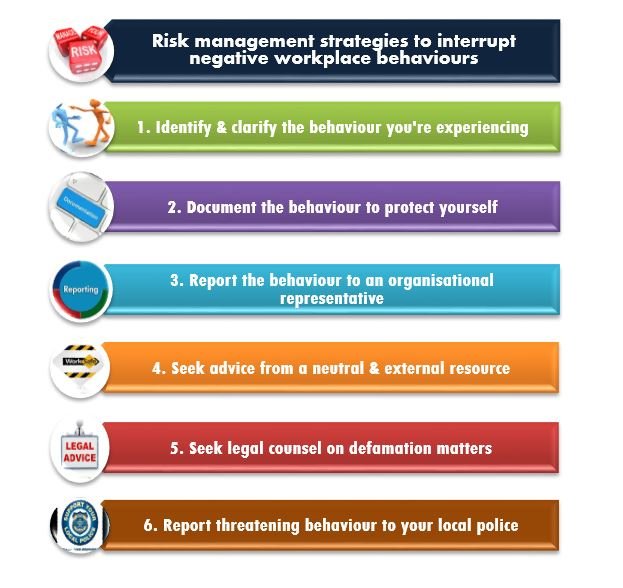Research – why ignoring workplace bullying is bad for you and workplace safety
Confronting bad workplace behaviour and standing up for yourself can be very hard, especially if you fear for your job. However, if you ignore it, the negative behaviours will only get worse and affect not just you, but your co-workers, friends and family. Research has found that, without intervention, the continuum of occupational violence will escalate from online or offline disrespect, intimidation into bullying, harassment and mobbing, to verbal and cyber assault and aggression. More information about occupational violence continuum can be read within this article.
Ignoring negative workplace behaviours is now viewed as an untenable risk to people’s well-being, and is increasingly deemed unproductive and uneconomical by employers. Workplaces characterised by high levels of face-to-face bullying also report heightened employee stress and unscheduled absenteeism as people withdraw from the work environment. In addition to these people, and financial costs, over half the adult participants in a 2013 survey across 10 countries reported cyberbullying, cyber-harassment and cyber-stalking occurring over workplace sms, email, and social media led to heated face-to-face interactions and eroded people’s personal privacy at work. These factors are a risk to workplace safety.
The following six risk management strategies can be used to interrupt unacceptable behaviours at work:

Risk management strategy #1: Identify and clarify the behaviour you are experiencing.
Do you find that the confrontations or interpersonal aggression is eroding your ability to defend yourself, undermining your confidence and making you hate coming to work? Is it negative face-to-face behaviour or online communications, or a mixture of both? Do you feel defenceless to protect yourself due to some sort of power imbalance? Do you feel threatened and unsafe at work? You need to know exactly what you’re dealing with, so Google “bullying behaviour” or “workplace discrimination” or “harassment” so you are across the definitions and the detail.
Risk management strategy #2: Document the behaviour.
Even if you have no intention of reporting the behaviour to HR, your supervisor or union, you may be called upon to provide evidence proving you are not bullying the bully. Research has found bullies are often more quick to use organisational processes to protect themselves from being investigated, so documenting the behaviour first is part of your risk management strategy.
Your documentation must include the dates and times of the events, who else was present, what was said, and the outcome. If you think a worksheet would help you document this behaviour, email me for a process that will assist you to journal the events, and by doing so, switch on the rational side of your brain and realise this behaviour is unacceptable.
Risk management strategy #3: Report the behaviour to your organisation’s HR or OHS representative.
Look, I know HR generally is generally castigated about their slow response to employee bullying complaints, but I still recommend you sit down and calmly share your report to HR and/or your supervisor (or their boss) and report that this behaviour is making you feel unsafe at work and eroding your productivity and well-being. The matter is likely to be officially filed and investigated. Remember, this is also about risk management in the event the bully reports on you first, which can happen. I recommend you also think about asking a neutral “party” to accompany you to this and any future meetings or mediations, such as a friend, mentor, work coach, family doctor, legal or union representative.
Risk management strategy #4: Seek advice, guidance and/or counsel from neutral, external sources.
Let’s say you’ve now reported the matter to HR and they advise that they will now investigate it, and to not talk to anyone about it. Or your organisation doesn’t have an HR area. In such cases, you can seek advice, guidance and counsel from a number of external authorities. These include seeking advice or counsel from the external OHS advisory agencies regarding your workplace rights under relevant occupational health and safety laws, or make an appointment with your doctor and ask to be referred to a psychologist for personal support.
Risk management strategy #5: Seek legal advice about your rights and responsibilities and those of your employer.
This step can be important if you are facing workplace defamation and are concerned about damage to your professional reputation and/or career, and affecting future job prospects and you and your family’s financial safety. This issue is becoming prevalent for cyberbullying cases, but as research has demonstrated, human communications are messy so one case is likely to include elements of negative online and offline behaviours. Try Google-ing workplace or employment legal advisors.
Risk management strategy #6: Report to your local police
If you feel threatened by abusive, bullying and intimidating online or offline workplace behaviours and communications, then report the matter to your local police.
The Safety Conversation Podcast: Listen now!
The Safety Conversation with SHP (previously the Safety and Health Podcast) aims to bring you the latest news, insights and legislation updates in the form of interviews, discussions and panel debates from leading figures within the profession.
Find us on Apple Podcasts, Spotify and Google Podcasts, subscribe and join the conversation today!



The article is very interesting which is worth reading it . Thanks for info .